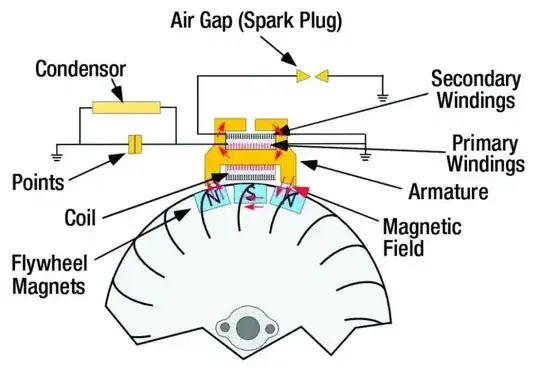I have a ignition coil I scavenged from a dead lawn mower and would like to play around with it. The problem though is it is not like a standard car ignition coil and I have no idea how to drive it. It seems like a magnet in the engine spins around and induces current and in turn a magnetic field in the primary to get high voltage from the secondary. My problem, though is it is impractical and annoying to do this, how can I drive the primary without a magnet? Or it might just be a matter of how to connect to the primary, but I don't know.
-
2Could you find something else that isn't quite so potentially lethal to play around with? What are you intending to do with it? – Andrew Morton Aug 16 '19 at 22:52
-
Seconding andrew; this is a pretty dangerous thing to be playing around with – Hearth Aug 16 '19 at 23:06
-
You've got a "magneto". That should be enough to start you on your research. – Transistor Aug 16 '19 at 23:09
-
@Nate - An ignition coil that is excited by a magnet on the flywheel would not even make sense to have any "primary" coil. Just an output winding that gets excited by the magnetic field the flying magnet induces into the core of the ignition coil. – Michael Karas Aug 16 '19 at 23:10
-
"sense to have any "primary" coil." Except that having a primary coil reduces the voltage requirements on the points. – TimWescott Aug 17 '19 at 00:04
-
So I take it y'all never pulled a plug out and checked for spark as you kicked the engine over? – hacktastical Aug 17 '19 at 04:40
-
@MichaelKaras magneto coils DO have primary and secondary. The magnet induces a few volts in the primary (or would if it wasn't short circuited. As a result in induces current in the primary. Then the points open, breaking the primary, giving an inductive kick of 150V when I measured it : no sparking at the points. But that kick is multiplied by the turns ratio in the secondary. Hopefully tt's the spark plug and not the wiring or the secondary that breaks down... – Aug 17 '19 at 12:35
-
@hacktastical : advice seen on a Seagull outboard motor site "Have someone you don't like very much hold the plug against the cylinder head, while you spin the flywheel" – Aug 17 '19 at 12:59
-
@BrianDrummond - My mistake that I made. Last time I tore down the small engine on my lawnmower a couple of years ago I just did not remember seeing a set of contact points. – Michael Karas Aug 17 '19 at 15:32
2 Answers
Short answer: you can't. This kind of ignition counts on the magnet passing the pole pieces.
This ignition system goes by a couple of names: magneto, energy-transfer, or very-strong-leg if you experience it on a vintage British motorcycle...
Below is illustration:
from here: https://www.hemmings.com/blog/article/magneto-ignition-systems/
How It Works
Your description is very close to being right on the money. The magnets in the flywheel fly past the pole pieces to make the flux change that energizes the coil while the points are still closed. At the peak of that flux, the points open, causing the flux to collapse rapidly. This collapsing flux induces a high voltage in the secondary, which finds its discharge path through the spark plug.
That all said, if you want to play with coils, find an old automotive or motorcycle type that uses battery current.
- 53,912
- 2
- 49
- 152
Re-visiting my comment and expanding it, I believe you can energise a magneto coil electrically.
Magneto coils DO have primary and secondary : see hacktastical's answer for a good description. The magnet induces a few volts in the primary (or would if it wasn't short circuited). As a result it induces current in the primary. Then the points open, breaking the primary, giving an inductive kick of 150V when I measured it : no sparking at the points (and the "condensor" = capacitor suppresses any tendency to spark there). But that kick is multiplied by the turns ratio in the secondary. Hopefully tt's the spark plug and not the wiring or the secondary that breaks down.
If you connected the primary to a low impedance voltage source (i.e. a "short circuit" to AC) a current I would build up according to V = L * dI/dT. (Probably more like 2V or 4V than 12V)
If you leave it long enough, the primary resistance will limit the current, otherwise you can limit the current by limiting the "on" time, dT.
Then if you break the circuit, you will get the inductive kick, and the multplied kick (several tens of kv) on the secondary.
If trying this, start by knowing primary resistance R, primary inductance L, to get a feel for dT. Ideally measure the peak current generated by the magnet (ammeter replacing the points, so no spark. And an ammeter won't be fast enough so you're looking at an oscilloscope across a low resistance shunt)
Then make sure you have:
- a spark plug across the secondary
- if you're breaking the circuit wit a transistor, it must be rated for several hundred volts
- also add something that WILL break down before the transistor (e.g. transient suppressor diode, or 250V zener) across the primary circuit
- and your hands nowhere near this thing when you switch it on or off.
